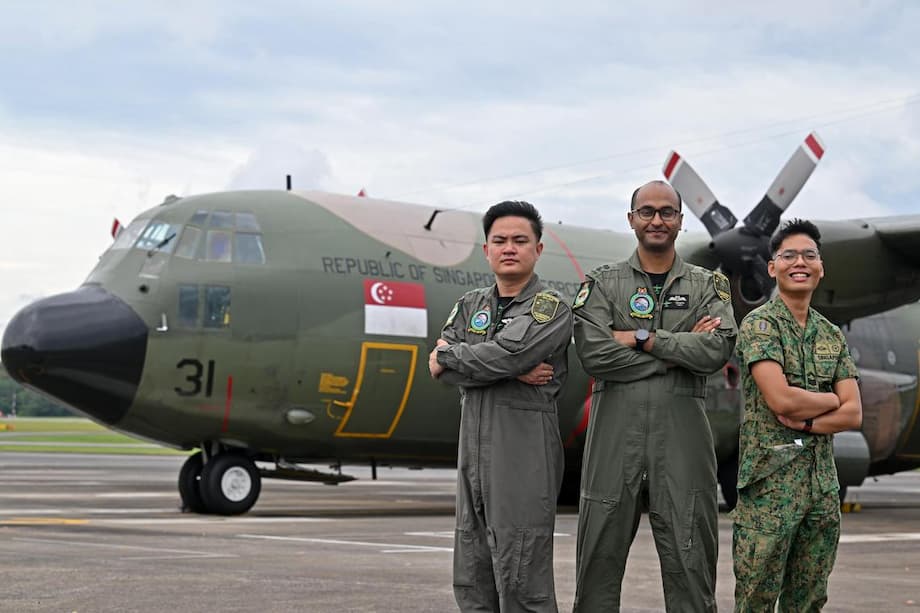A Two Week Mission From Jordan to Gaza Skies
Singapore has completed a two week humanitarian air drop mission to Gaza, flying from Jordan and delivering 14.9 tonnes of relief supplies into the enclave. The operation, conducted from August 12 to 25, involved a Republic of Singapore Air Force C-130 transport aircraft flying five sorties alongside foreign air forces. The mission formed Singapore’s ninth tranche of humanitarian assistance for Gaza since the war escalated in late 2023, and the second time the C-130 has executed air drop operations over the territory.
- A Two Week Mission From Jordan to Gaza Skies
- What Was Delivered and Who Contributed
- How Airdrops Work in a Conflict Zone
- Partnerships with Jordan and Foreign Air Forces
- Why Airdrops Are Used, and Their Limits
- From March 2024 to August 2025, How Singapore Scaled Up
- Voices from the Crew
- Official Messages of Support
- What Happens After an Airdrop
- Key Points
The Singapore Armed Forces contingent, made up of 58 personnel and supported by the Singapore Army’s 3rd SAF Transport Battalion and defence partners, deployed to a Jordanian base at the invitation of the Jordanian government. According to the Ministry of Defence, the crew have returned safely to Singapore following the successful delivery of the supplies. The Changi Regional Humanitarian Assistance and Disaster Relief Coordination Centre consolidated the relief cargo before departure, a process that has enabled government agencies and charities to move quickly when a flight window opens.
Singapore first carried out an air drop to Gaza on March 20, 2024, after land routes into the territory repeatedly closed or slowed. The latest mission underscores the use of air drops as a last resort when ground access is constrained, while highlighting the careful planning and multinational cooperation required to release cargo safely over a densely populated and war affected area.
In public remarks, Singapore’s leaders and senior officers stressed both the urgency of getting aid in and the precision demanded by each release. The operation also reflected Singapore’s effort to contribute in a practical way to a dire humanitarian situation, with crews and riggers working under punishing heat while managing the risks of flying near an active conflict zone.
What Was Delivered and Who Contributed
The latest tranche consisted of medical supplies from Singapore’s Ministry of Health and food items provided by local non governmental organisations. Medical consignments in missions of this kind typically include dressings, antibiotics, pain relief, trauma kits, and basic equipment intended to stabilize injuries and treat common illnesses that surge when infrastructure is damaged. Food parcels are designed to be shelf stable and easy to consume, such as rice, canned goods, pulses, and nutrition packs.
The relief effort drew on a network of Singapore based charities that have managed fundraising, procurement, and packaging since the conflict escalated. The participating partners for this tranche included:
- Humanity Matters
- Caritas Humanitarian Aid and Relief Initiatives Singapore
- Mercy Relief
- Rahmatan Lil Alamin Foundation
Working with the Changi coordination center, these groups channelled donations into standardized packages that can be rigged for aerial delivery. Since October 2023, the nine tranches of aid from Singapore and Singaporeans have been valued at over S$22 million, reflecting sustained public support at home for humanitarian relief.
How Airdrops Work in a Conflict Zone
An air drop is as much a ground job as it is a flying task. Before a single pallet leaves the aircraft, aerial cargo riggers assemble loads with parachutes, static lines, and protective padding. Loadmasters weigh and balance each pallet, calculate the order of release, and ensure that straps and containers meet strict safety standards. Pilots, navigators, and flight engineers then execute the run at the designated altitude and speed, computing wind drift and terrain effects so that the cargo falls into a safe area.
Operations in Gaza magnify each of these steps. There are no controllers on the ground to guide pilots with smoke or signal panels, which is common in training. Crews must assess the drop zone in real time from the air, confirm that the area is free of people and buildings, and adjust to changing winds, visibility, and air traffic. The aircraft often flies in a corridor that is tightly managed, with other humanitarian flights entering and exiting the same airspace on a schedule shaped by regional authorities.
Rigging, inspection and safety
Singapore’s team described a rigorous process that typically takes up to a full day of preparation before each flight. Aerial cargo riggers from the Singapore Army assembled and inspected the parachute systems and tiedowns, while RSAF loadmasters conducted independent checks. Detailed manifests ensure each pallet is accounted for, and the aircraft’s floor plan is set to release cargo in the correct sequence over the drop zone. That sequence, along with navigation waypoints and release parameters, is refined in mission planning meetings, then verified again during pre flight checks.
Deconfliction in crowded airspace
In Jordan, Singaporean personnel met daily with the Jordanian air force and other foreign air forces to deconflict routes, altitudes, and timing. The goal is to prevent congestion in the sky and to make sure radio calls are clear and consistent. This kind of coordination is essential in a busy humanitarian corridor where multiple nations may be flying in the same window. Teams also study weather updates, particularly wind profiles at drop altitude, since even a small shift can move a pallet off course.
Partnerships with Jordan and Foreign Air Forces
Jordan’s invitation and staging support made the mission possible. The RSAF deployed from Paya Lebar Air Base to a Jordanian air base, where the crew worked shoulder to shoulder with counterparts from several countries. Leaders from Singapore’s defence ministry and the Office of the Minister in charge of Muslim Affairs attended a send off event to thank the NGOs and the crew. During the deployment, Singapore officials met senior Jordanian commanders to express appreciation for Jordan’s role in facilitating the air corridor and planning meetings.
International reporting highlighted the multilateral nature of the effort. On one of the mission days, Israeli media noted that seven countries, including Singapore, conducted a joint air drop that released 127 packages over Gaza. This reflects how these flights are often organized in clusters to maximize available windows and to streamline coordination with regional authorities.
Singapore’s Defence Ministry later confirmed the operation’s completion, adding that the C-130 flew five sorties, a total that matches the planning tempo common for such deployments. The aircraft and crew returned home safely after the final delivery and post mission checks.
Why Airdrops Are Used, and Their Limits
When roads into an area are blocked, damaged, or too dangerous, air drops can move aid quickly without a ground convoy. They can reach isolated communities and they avoid bottlenecks at crossings. For people who have been cut off for days, a pallet of food rations or a crate of medical supplies can provide immediate relief until larger deliveries resume.
Air drops also present clear limits. A single C-130 pallet carries far less than a truck, and cargo released from altitude can be hard to control in high winds or urban settings. Crowds can rush toward falling bundles or converge on a landing area too quickly, which creates safety concerns as parachutes and heavy containers descend. Deliveries are intermittent rather than continuous, and each run requires a short window of airspace access and careful routing to reduce risk to the aircraft and people on the ground.
These realities are why humanitarian organizations often describe air drops as a complement to, not a substitute for, land routes. Even so, when ground access narrows, air drops can keep a lifeline in place. For the Singapore mission, the focus was on identified release areas, standardized packages, and rigorous pre flight planning. Crew members constantly reviewed contingencies to raise the chances that each bundle landed clear of buildings and that people were not under the descent path.
The challenge in Gaza has been compounded by continued fighting, shifting front lines, and damaged infrastructure. In that environment, each safe delivery is the result of coordination across governments, militaries, and charities working within short time windows.
From March 2024 to August 2025, How Singapore Scaled Up
Singapore’s first Gaza air drop on March 20, 2024, established processes that were applied again in August 2025. Across nine tranches, support from government agencies and NGOs helped move consignments worth more than S$22 million. The August mission was the second air drop operation and involved more sorties, greater exposure to the Jordan based planning system, and tighter integration with foreign crews flying similar profiles.
Chief of Air Force Major General Kelvin Fan framed the August outcome as proof that crews can mobilize quickly and execute demanding tasks. Introducing his remarks, the Defence Ministry said the Chief thanked servicemen and women, defence partners, families, the Changi coordination center, and NGOs for their part in the deployment.
Major General Kelvin Fan said the outcome is a testament to operational readiness and the ability to conduct operations at short notice. He thanked the servicemen and women, defence partners and NGOs for their commitment and support.
Voices from the Crew
The people behind the statistics described a mission shaped by heat, precision, and purpose. First Sergeant Muhammad Faisal Sharudin, an aerial cargo rigger, worked on the flight line in Jordan while his fiancee managed their wedding preparations in Singapore. He said he was nervous before the deployment, then found confidence in training and in the knowledge that each safe drop could make a difference to families in Gaza. His team faced midday temperatures near 45 degrees Celsius, so they kept a strict rest and hydration routine to maintain performance and safety.
Lieutenant Colonel C. Teeneshwaran, the air mission commander and commanding officer in 122 Squadron, described a dynamic airspace and an operation that demanded constant coordination. The team was not flying alone. Every flight plan, altitude, and timing segment had to be aligned with partners to keep air lanes clear. In the cockpit and ramp area, crews rehearsed how they would respond if winds shifted or if a release had to be delayed by seconds to keep a bundle away from structures on the ground.
For the loadmasters and riggers, the experience underscored the value of discipline and mentorship. Army and RSAF personnel spoke about passing lessons learned to younger crews, from how to build and pad a pallet to the last checks before a green light. They stressed that the work matters to people waiting on the ground, so attention to detail is not just a safety rule, it is a part of the humanitarian mission itself.
Official Messages of Support
Senior Minister of State for Defence Zaqy Mohamad attended the deployment ceremony in Singapore and later met Jordanian leaders during the mission period. He praised the crews and the community of donors for standing together to help civilians in need. Introducing his remarks, Singapore’s defence authorities noted his emphasis on both readiness and compassion.
Mr Zaqy Mohamad said the SAF stands ready to support humanitarian assistance into Gaza and that the whole community rallies together to show compassion. He highlighted the professionalism and commitment that made the mission possible.
Acting Minister in charge of Muslim Affairs Associate Professor Faishal Ibrahim thanked the Muslim community and all Singaporeans for their generosity. His message connected individual acts of giving with the morale of people in crisis.
Associate Professor Faishal Ibrahim said: Every act of giving is a light in the darkness for someone in need. He encouraged continued support for humanitarian initiatives and prayers for Gaza.
What Happens After an Airdrop
After a pallet lands, the real work begins. In a standard humanitarian air drop, local partners or international agencies move quickly to retrieve packages from the landing area, bring them to safe distribution points, and match supplies with the needs of nearby communities. That step can be difficult in a war zone, where roads are damaged, communications are disrupted, and movement may be restricted. The planning teams therefore try to select release areas that are accessible and as secure as possible within the limits of the situation on the ground.
Air drops also rely on constant communication among militaries that control the airspace. Deconfliction aims to reduce the risk of aircraft coming too close to one another and to lower the chance of supplies drifting into dangerous areas. The wider security environment can shift quickly. During the same period that air drops were taking place in mid August, Israel’s military announced separate operations in northern Gaza, a reminder that dynamics on the ground can change between planning and release time.
These complications are why air drops are used to bridge gaps in aid access. Relief groups continue to press for sustained road access at scale, while governments and militaries keep air corridors available when ground routes narrow. In the August mission, Singapore’s role focused on precision delivery, safe conduct, and close coordination with partners tasked to move and distribute the aid after it reached the ground.
Key Points
- Singapore completed a two week air drop mission from Aug 12 to 25, delivering 14.9 tonnes of aid into Gaza in five sorties.
- The operation was the second air drop by the RSAF over Gaza and formed the ninth tranche of aid from Singapore since October 2023.
- Fifty eight personnel deployed, including RSAF aircrew, Singapore Army riggers, and defence partners, operating from a Jordanian base.
- Medical supplies from the Ministry of Health and food items from four Singapore NGOs were consolidated by the Changi coordination center.
- Daily joint planning with Jordan and other foreign air forces deconflicted airspace, routes, and timing.
- Air drops provide relief when roads are closed or unsafe, though they carry limits on volume, accuracy, and frequency.
- Chief of Air Force MG Kelvin Fan praised the team’s readiness, while leaders thanked Jordan and the Singapore community of donors.
- Crews described intense heat, heavy preparation, and a strong sense of purpose as they worked to ensure each pallet landed safely.




